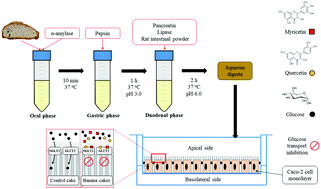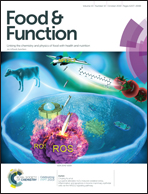Banana flour phenolics inhibit trans-epithelial glucose transport from wheat cakes in a coupled in vitro digestion/Caco-2 cell intestinal model†
Abstract
Some fruit phenolics are reported to attenuate intestinal glucose transport through inhibitory action at the luminal brush border membrane. This effect may contribute, in part, to the ability of flavonoid-rich food to regulate glucose homeostasis of meals rich in available carbohydrates. For the first time, the potential of green banana flours to inhibit transepithelial glucose transport was investigated in the context of a model starchy meal (wheat cake) using a simulated digestion/Caco-2 human intestinal cell model. A 10% replacement of wheat flour with any of the four banana flours (native and extruded oven-dried and freeze-dried) resulted in cakes with significantly higher total phenolics (68–198 μg per 100 g, p < 0.05), especially using extruded banana flour (197–198 μg per 100 g), as measured by LC/MS. Banana cakes, especially those containing oven-dried and/or extruded banana flours, exhibited from 45.0 to 54.5% higher glucose transport inhibition than the control cake. Interestingly, the digesta of cakes made with freeze-dried and extruded banana flour presented a significantly higher phenolic content (1116 μM, p < 0.05) than the other digesta (745–791 μM), while the phenolic content in control digesta was only 548 μM. These results suggested that the amounts of quercetin and myricetin, even in traces, were critical determinants of glucose transport inhibition.



 Please wait while we load your content...
Please wait while we load your content...